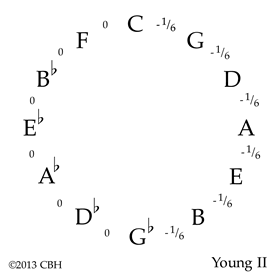Technical Library
TEMPERAMENTS XIX: Young II
Entire Contents Copyright © 2021 CBHTechnical LibraryTEMPERAMENTS XIX: Young II Entire Contents Copyright © 2021 CBH |
 WIKIMEDIA COMMONS / PUBLIC DOMAIN |
| Thomas Young (1773–1829) |
Thomas Young (1773–1829) had his finger in almost every scientific research pie around the turn of the nineteenth century: Egyptology, the theory of light, and a little music besides.
His second temperament, proposed to the Royal Society in 1800, is very similar to Vallotti, except Young’s tempered fifths run from around the sharp side of C instead of from F. This is effectively Vallotti transposed up a fifth because we are just spinning the dial a single notch—and probably why this temperament is sometimes known as Shifted Vallotti/Young on some temperament apps. (See the difference by putting your mouse over the diagram below and then removing it.)
Remembering that in temperaments like this, the keys with narrow fifths have the better sounding thirds. You can therefore appreciate that Young offers a slight improvement in the sharp keys over Vallotti. The triads on C and G have the same color in both temperaments, the improvement commencing with D, at the expense of some niceness about F and the other flat keys, progressively and even because (like Vallotti) it looks so tidy in the circle with all the narrow fifths together.
I only decided at Colin van der Lecq’s behest to put some tuning instructions for Young on this site—after Philip Pickett requested Colin tune the organ and harpsichord to this temperament for the New London Consort performances at the 2008 Perth International Arts Festival. It was also used for the November 2013 tour of Academy of Ancient Music with Richard Egarr, and a new Vivaldi recording by the Australian Chamber Orchestra in March 2014.
Examining the diagram, you can see that all you really have to do is tune a chain of six pure fifths around the flat side of C, and then work on the fifths on the sharp side of C, making them all equally narrow. Like Vallotti, these narrowed fifths are twice as narrow as Equal Temperament, so the Young-tempered fifths beat exactly twice the speed of Equal Tempered fifths.
 It’s easiest tuning Young from scratch by working from C. If you do that, though, your A will be lower than your instrumentalist friends expect so they may not be happy. It’s worth a try anyway, so proceed as follows:
It’s easiest tuning Young from scratch by working from C. If you do that, though, your A will be lower than your instrumentalist friends expect so they may not be happy. It’s worth a try anyway, so proceed as follows:
1. Tune your c'' to a tuning fork, and tune middle c' in absolute perfect tune a beatless octave below it.
2. Tune all the fifths from the flat side of C around the circle of keys absolutely pure until you hit G♭. Remember, pure means no beats.
3. Tune e' pure to middle c' and then raise the e' until that third beats at four times per second. Look at the second hand on your watch, if you want. Tune down a pure octave to e.
4. Determine your b between e and f♯', leaving both fifths narrow. These are the same sixth-comma fifths as Vallotti, and beating twice as fast as the same interval in Equal Temperament—if that’s a help to you. Of course, you already know from these pages that if the fifths are the same theoretical size, the one higher up the keyboard must beat considerably faster because frequency doubles at the octave.
5. Tune g' pure to middle c', then lower your g' until you have a similar narrow fifth, comparing middle c'–g' if anything beating ever so slightly faster than b–f♯'. Tune a pure octave from g' down to g.
6. Tune a pure to e', then raise your a until you have a similar narrow fifth, comparing a–e', beating slightly slower than b–f♯'. Tune a pure octave up from a to a'.
7. This leaves poor d' to last. You can determine it the same way, tuning a pure fifth up from g, and then lowering your d' until you recognize the slow wave of a sixth-comma fifth. You must also have a sixth-comma fifth between d' and a'.
8. Finally, compare all your narrow fifths ascending the keyboard, with slightly increasing beat speeds for each one: e–b, g–d', a–e', b–f♯', c–g' and d–a'. Every other fifth must be perfectly beatless.
If you’ve just tuned Vallotti, it’s easy to convert that temperament to Young just by lowering all the flat keys:
1. Lower your f slightly from the sixth-comma narrow fifth of Vallotti, until it makes a pure fifth below middle c'.
2. Continue resetting all the flats in pure fifths from your new f. You must do this five further times until you hit G♭. When finished, you will have a total of six narrow fifths, and six pure fifths.
It’s a bit more difficult starting Young from a' rather than from middle c', but well within your capabilities if you’ve mastered Vallotti because you already know the sound of sixth-comma narrow fifths. It is so incredibly useful to remember that the third f–a is set at three whole beats per second for Vallotti that we will do it that way. Your instrumental cohorts will be happy because your a' will be spot on:
1. Tune your a' to a tuning fork, and tune a in absolute perfect tune a beatless octave below it.
2. Now we want to set the f a third below that a: Tune it pure first of all, but then widen the interval by flattening the f until you hear three distinct beats per second. This is only a temporary position for the f—we must eventually flatten it some more.
3. Using the temporary position of F, we are going to narrow all the fifths in the circle between F and A by exactly the same amount, a sixth-comma. All these tempered fifths are narrow, so must be squeezed. Tune middle c' pure to f, then squeeze the interval by lowering your middle c' a little until you hear a lazy beat of a bit more than once a second.
4. Tune d' pure to a', then raise your d' a little, again squeezing the interval so it has a perceptible but not overly blatant wave. This interval will beat a tad less than twice per second, so check it against the second hand on your watch until you have a good wow-wow, wow-wow. It helps to replay the interval every second or so—listen when the notes are fresh so you don’t have to struggle to hear the beats while the sound is dying away.
5. Tune g a beatless fifth below d', then squeeze the interval by raising the g. Compare f–c' to g–d': These two intervals are the same size—the first only temporarily—so they should sound pretty similar for now. The f–c' fifth is a tone lower, so if your intervals are to be the same theoretical size, f–c' should beat marginally slower than g–d', but don’t fuss needlessly.
6. Tune g' up an octave from g. Compare c'–g' to d'–a': These two intervals are the same size, so again they should sound pretty similar. If not, a little error may have crept in, so juggle all these fifths until you are happy with their uniform roughness. Don’t move your a, nor your f just yet!
7. Tune e' pure to a, then lower it a little, squeezing the interval so it has a perceptible but not overly blatant wave. Compare g–d' to a–e'. Now drop down the octave from e' to e, which of course must be tuned pure.
8. Another narrow fifth is e–b. Check this interval against against f–c', g–d' and a–e': Each one should beat just a little more than the previous as you ascend the keyboard.
9. Now lower your f to its final position, a pure fifth below middle c', rather than Vallotti’s three beats per second below a.
10. Tune all the fifths from the flat side of F around the circle of keys absolutely pure until you hit G♭. This final note makes your last narrow fifth b–f♯', which we haven't intentionally tuned. Check it for size against a–e'.
11. Finally, compare all your narrow fifths ascending the keyboard, with slightly increasing beat speeds for each one: e–b, g–d', a–e', b–f♯', c–g' and d–a'. Every other fifth must be perfectly beatless.
Further discussion
Anonymous [Kayano, Moxzan] Dodecagon — Chi-s akt temo Tokyo 2012, p86
Barbour, J Murray Tuning and Temperament Michigan State College Press, East Lansing 1951, p163
Jorgensen, Owen The Equal-beating Temperaments The Sunbury Press, Raleigh 1981, p27
Padgham, Charles The Well-Tempered Organ Positive Press, Oxford 1986, p88
| Pitch nomenclature | |
| Harpsichord Tuning Process | |
| Tuning Bibliography | |
| Technical Library overview | |
| Harpsichords Australia Home Page |